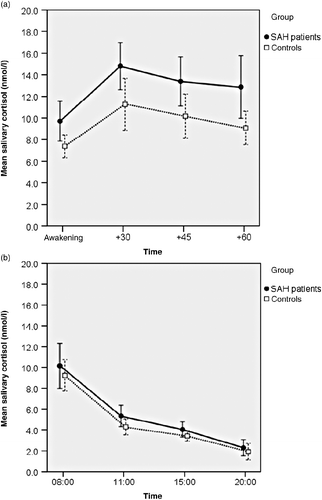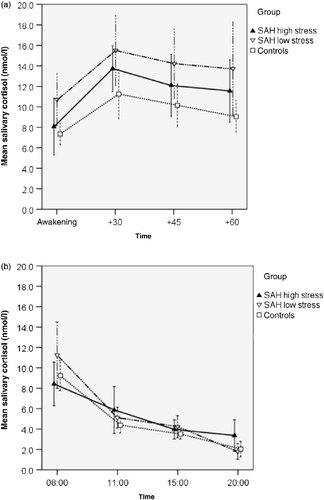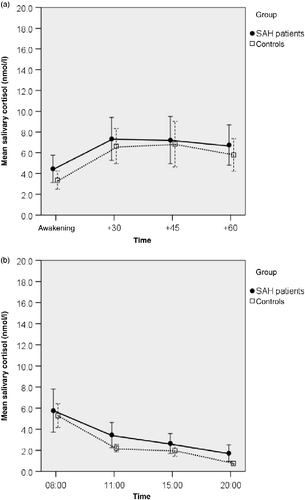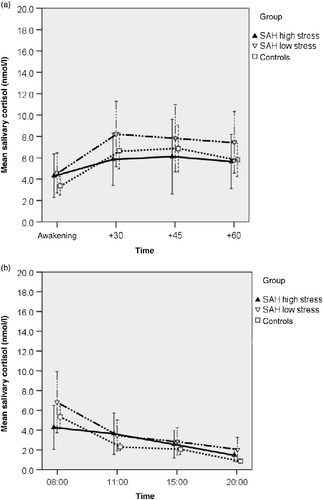Figures & data
Table I. Descriptive data.
Figure 1. Salivary cortisol concentrations in patients after subarachnoid haemorrhage (SAH patients) and controls. (a) Post-awakening. Patients exhibited significantly greater salivary cortisol concentrations than controls; p = 0.013, ANOVA; n = 31 SAH patients, n = 25 controls. (b) Diurnal variation. Profiles did not differ between groups; p = 0.14, ANOVA, n = 31 SAH patients, n = 24 controls. Values are mean salivary cortisol concentrations for each group; whiskers represent 95% confidence intervals. Time scale (a) is in minutes, (b) is time of day, h.

Figure 2. Salivary cortisol concentrations in patients after subarachnoid haemorrhage (SAH patients) categorized as low or high stress and controls. Stress level was determined by NeuropatternTM. (a) Post-awakening. Salivary cortisol concentrations in the SAH low-stress group (n = 19), but not the high-stress group (n = 12), were significantly greater than those in controls (n = 25); p = 0.022, ANOVA; post-hoc Tukey-HSD: p = 0.016. (b) Diurnal variation. Diurnal cortisol concentrations for patients after SAH with high stress (n = 12) or low stress (n = 19) and controls (n = 24). There were no significant differences among the three groups (p = 0.22, ANOVA). Values are mean salivary cortisol concentrations for each group; whiskers represent 95% confidence interval. Time scale (a) is in minutes, (b) is time of day, h.

Figure 3. Salivary cortisol concentrations after administration of 0.25 μg DEX the evening before sampling (23:00 h) in patients after subarachnoid haemorrhage (SAH patients) and controls. a: Post-awakening, n = 31 SAH patients, n = 23 controls. b: Diurnal variation, n = 31 SAH patients, n = 23 controls. No statistically significant interaction between group (SAH/controls) and DEX (suppression yes/no: data for ‘no DEX’ shown are in Figure 1) was observed (Post-awakening: F (1,103) = 1.727, p = 0.19, ANOVA; diurnal profile: F (1,99) = 0.007, p = 0.94, ANOVA; compare Figure 1a,b). Values are mean salivary cortisol concentrations for each group; whiskers represent 95% confidence interval. Time scale (a) is in minutes, (b) is time of day, h.

Figure 4. Salivary cortisol concentrations after administration of 0.25 μg DEX the evening before sampling (23:00 h) in patients after subarachnoid haemorrhage (SAH patients) categorized as low or high stress, and controls. Stress level was determined by NeuropatternTM. There were no statistically significant group differences (a) post-awakening. (F (2,48) = 0.607, p = 0.55, ANOVA) or (b) in the diurnal cortisol profiles (F (2,45) = 1.199, p = 0.31, ANOVA). Values are mean salivary cortisol concentrations for each group; whiskers represent 95% confidence interval. Time scale (a) is in minutes, (b) is time of day, h.

